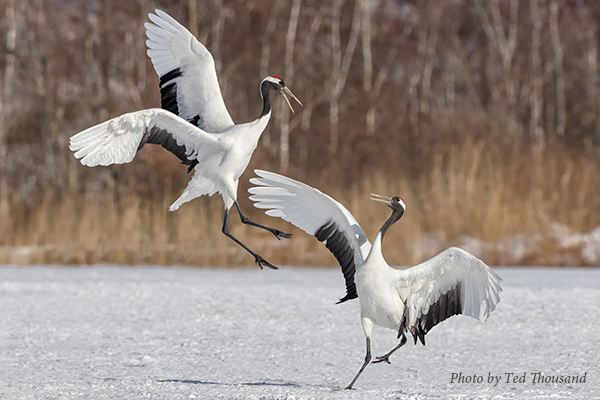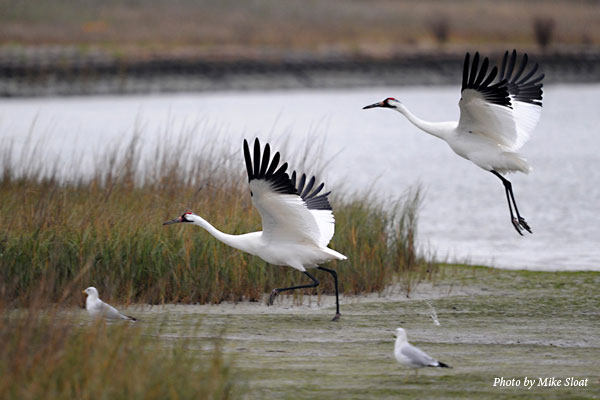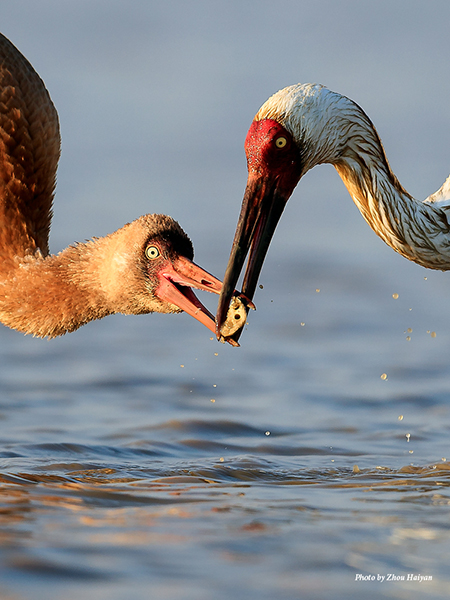
Dear Friends,
I find that I can stay pretty focused while working at home these days, ignoring the goings-on of my home-bound family, the barking dog, and robo phone calls when I really need to get a job done. But I have a big weakness for birds! A red-bellied woodpecker on the feeders outside my window will draw me out of my deepest concentration. I’m hopelessly distracted by scolding chickadees. And as much as I love all the bustling activity, I equally delight in the stillness when a prowling Cooper’s hawk casts a temporary shadow over my feeder community.
We are bird watching from home in record numbers these days, monitoring our feeders like never before, cheering the return of spring migrants. Some of our members are even seeing Sandhill Cranes on their feeders, as their remarkable recovery pushes them into urbanizing areas where prairies and wetlands once dominated the landscape.
Globally, the relationship between cranes and feeding stations is an important but very complicated conservation story (and people story).

In Texas, some of the wintering Whooping Cranes outside of Aransas National Wildlife Refuge have discovered the tasty piles of corn at deer feeders. These feeders are occasionally a lifeline during times of severe drought, when blue crabs and wolfberries may be hard to come by. But during years when the marshes are healthy, feeders can be a problem, increasing the risk of Whooping Cranes becoming habituated – and more vulnerable – to people, dogs, and other threats. We also have concerns about the impact of changing diets on their nutrition. Liz Smith, Director of North America Programs, and our team in Texas is working to reduce artificial feeding during those years, to ensure our wild Whooping Cranes stay wild.
In Japan, the resident population of Endangered Red-crowned Cranes on the island of Hokkaido depends on feeding stations, and more than 15,000 Vulnerable Hooded Cranes and White-naped Cranes winter on artificial feeding stations in the southern city of Izumi. These feeding stations were vital to the recovery of these crane populations after World War II, but today the cranes are highly concentrated, and the risk of disease outbreak is ever-present.
Long before the current outbreak of COVID-19 brought heightened attention to the spread of disease among animal populations and between animals and people, we have been encouraging our Japanese craniac partners to disperse these concentrated flocks through the protection and restoration of natural wintering habitat and the gradual reduction in feeding stations. At the same time, we are working to ensure that vital breeding, staging, and wintering habitat on the mainland in Asia is protected and well-managed to sustain these species.

And then there is Poyang Lake in China, one of the world’s most important sanctuaries for migratory waterbirds and home to millions of wintering waterbirds including almost the entire population of Critically Endangered Siberian Cranes, swan geese, whistling swans, Oriental white storks, and many others. Most years, natural water level fluctuations on Poyang Lake provide abundant natural food supplies for cranes and other waterbirds. But when feeding conditions at Poyang Lake are poor due to excessive floods or drought, the cranes have recently concentrated in huge numbers on neighboring lotus ponds – an important but risky fallback for the species. If cranes shift more to agricultural areas in China, we are especially concerned about the impact of pesticides and other poisons that are heavily used to control crop depredation on these lands.
Our great team in China has been working at Poyang Lake for decades to help reserve managers maintain optimal conditions for cranes and other biodiversity, and prevent dams, sand dredging, and other development that would irreversibly damage the lake. But when natural food supplies run low, as they did last winter, the lotus ponds can provide a refuge that is relatively secure and well-monitored, in contrast to neighboring agricultural areas. The fact that Siberian Cranes do not use the lotus ponds in years of good natural food supply is encouraging, but we have to be careful to not encourage efforts to attract the cranes more permanently to lotus ponds for tourism and photography, which could make the population more vulnerable in the long run.
As elsewhere around the world, it is a balance. We are happy that people are showing an increased appreciation and desire to help cranes and we support feeding stations as a backup during times of stress, but we will continue to focus deeply on maintaining the natural ecological conditions that best support cranes and the rich biodiversity of life that share these remarkable wetlands. Even during these challenging times, that need remains great.

Wishing you good health, plenty of fresh air, and the joy of bird watching in the days ahead,
Rich Beilfuss
President and CEO
